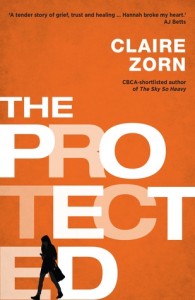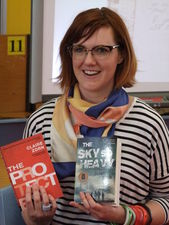 Some stories touch your heart – is that why you like them?
Some stories touch your heart – is that why you like them?
For me, there are so many touchpoints in this novel – identifying with loss of a sibling, road-tripping and typical working out ‘who you are’ as a teenager.
All this comes about as Zoey’s life crashes into oblivion following the tragic death of her brother. Unable to cope, she spirals away from her friends as they try to help her, and away from parents dealing with their own grief. Fortunately, a wakeup call (finding herself passed out at the wheel of her car) and an invitation to join her ex-boyfriend on a road-trip pulls her back into reality – a little.
Her plan is to get back with Finn, her ex, even though Cassie, her best friend is also coming on the trip.
As they travel from Adelaide to Melbourne with Finn’s cousins, Zoey works through memories and actions of the past. This is mainly generated by the questions and taunts of Finn’s super attractive but sullen cousin, Luc – Mr Grumpy she calls him.

Drawn together by the road-trip, it seems they have a little more in common as time progresses and they learn about each other. The trip itself is buoyed along by Luc’s effervescent younger sister, Jolie. It seems no-one else is too bothered to plan, so she guides their itinerary.
Along the way, Zoey begins to see things differently, and events lead to an exploration of friendships and family relationships – her old friends, her new friends and different family dynamics around her. It’s an emotional story (tissues please).
‘Losing a loved one is the hardest thing, and I think it changes a person forever.’ Author ,Beck Nicholas, in Acknowledgements, p.333.
It certainly changed Zoey. Now is she ready to change again?
Will she win Finn back? Can she do that to her best friend, Cass?
And how long can she put up with Luc’s brooding behaviour? Will she just do that to appease her newfound friend, his sister, Jolie?
More importantly, can past mistakes finally be forgiven?
# NOTE: The copy I read was a ‘dyslexic friendly’ book, which I personally found difficult. From what I have read, I can see that the font used could help somewhat. However, why hasn’t the publisher used left alignment for the text? since justification of text removes prompts required for a dyslexic friendly style.
 Ana lives in a detention centre in Darwin, having escaped her home in Iran, and initially being transported to Nauru. From Wickham Point Immigration Centre, she is able to attend school, but that is about all. No freedom. No hope. No life.
Ana lives in a detention centre in Darwin, having escaped her home in Iran, and initially being transported to Nauru. From Wickham Point Immigration Centre, she is able to attend school, but that is about all. No freedom. No hope. No life.
 It’s Easy Being Teen. Right? Not always…
It’s Easy Being Teen. Right? Not always… My daughter commented the other day about how many new books she had read recently were now using flashbacks and multiple viewpoints*. This may have related to the genre she has been reading (several crime and mystery stories), but I certainly reflected on this comment as I read ‘the Van Apfel Girls are Gone’ – flashbacks are crucial.
My daughter commented the other day about how many new books she had read recently were now using flashbacks and multiple viewpoints*. This may have related to the genre she has been reading (several crime and mystery stories), but I certainly reflected on this comment as I read ‘the Van Apfel Girls are Gone’ – flashbacks are crucial. Wearing Paper Dresses is a story you can feel. In its pages, even a city-slicker can begin to understand the stresses and strains of rural life – and to anticipate the troubles to come.
Wearing Paper Dresses is a story you can feel. In its pages, even a city-slicker can begin to understand the stresses and strains of rural life – and to anticipate the troubles to come.


 These are all great examples for youth to follow – people like Dylan Alcott, Ellyse Perry, Bindi Irwin and Jess Mauboy (names we know), as well as young achievers making a difference, perhaps yet to be household names?
These are all great examples for youth to follow – people like Dylan Alcott, Ellyse Perry, Bindi Irwin and Jess Mauboy (names we know), as well as young achievers making a difference, perhaps yet to be household names? Each of the bio’s features fabulous illustrative interpretations of the person highlighted. Good news too that the proceeds from the sales of these books will be donated to the Smith Family to help disadvantaged young Australians. Great acknowledgement of people making a difference – and a charity supporting others who could with a little bit of help.
Each of the bio’s features fabulous illustrative interpretations of the person highlighted. Good news too that the proceeds from the sales of these books will be donated to the Smith Family to help disadvantaged young Australians. Great acknowledgement of people making a difference – and a charity supporting others who could with a little bit of help.
 “There are lots of things worse than school.”
“There are lots of things worse than school.”
 Of course, even Claire would look up to another winner in these awards, who has been winning great accolades since 1986 – Bob Graham, Australian author and illustrator of children’s picture books! Bob won again this year with his book called Home in the Rain – “a tender, touching story of family life, perfect for sharing when a new baby is on the way. A beautifully observed celebration of the way inspiration can, and often does happen in the most ordinary and unlikely of places.” (
Of course, even Claire would look up to another winner in these awards, who has been winning great accolades since 1986 – Bob Graham, Australian author and illustrator of children’s picture books! Bob won again this year with his book called Home in the Rain – “a tender, touching story of family life, perfect for sharing when a new baby is on the way. A beautifully observed celebration of the way inspiration can, and often does happen in the most ordinary and unlikely of places.” (

